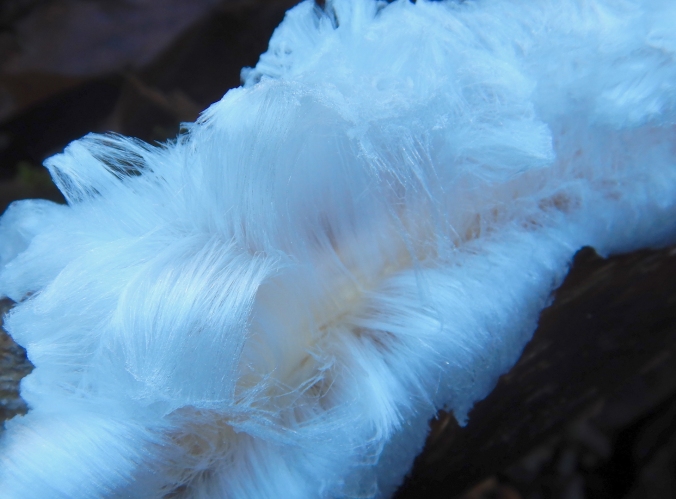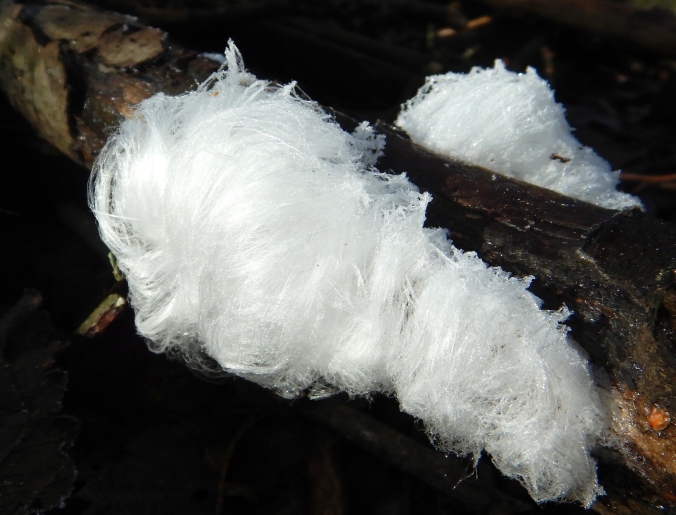Late one frosty morning, I paused my walk to admire ice crystals that had grown from a small branch lying on the ground. Delicate and lacy to the extreme, the ice had a silky and well-kempt appearance. The formation was gorgeous.

This was my first glimpse of hair ice, a phenomenon that originates in a surprising way.
If you live in a temperate climate that experiences hard frosts, you might be familiar needle ice. Even though it forms on frosty nights, this type of ice isn’t frost because it doesn’t condense out of the atmosphere. According Dr. James Carter of Illinois State University, it forms instead from in water in soil through ice segregation, a process when “above freezing and below freezing temperatures are juxtaposed. At the Earth’s surface this is most common in fall at night as the air cools to below freezing while the land surface stays relatively warm.” As ice forms on the soil surface, liquid water is pulled up from below through capillary action and freezes to the existing ice. This forces the ice to grow away from the freezing surface. The process stops when the temperature becomes cold enough to freeze everything up, the temperature rises above the freezing point of water and everything melts, or the soil surface becomes too dry.
Hair ice however, forms under even more specific, and perhaps unusual, circumstances. Like needle ice in soil, hair ice needs air temperatures just below freezing and a water saturated substrate. Unlike needle ice though, hair ice forms only on wood, specifically the dead and bark-free wood of broadleaf trees. Why only on dead wood?

 See more photos of hair ice on iNaturalist
See more photos of hair ice on iNaturalist
In 2015, researchers from Germany and Switzerland published a very interesting (and highly readable for a scientific paper) study titled, “Evidence for the Biological Shaping of Hair Ice.” Through repeated observations and laboratory experiments, they confirmed that the biological action of a winter-active fungus, Exidiopsis effuse, is required to enable the growth of hair ice.
Looking at the cross section of a small branch, wood rays radiate from the center of a branch like spokes on a bicycle wheel. From these rays, hair ice threads emerge and grow perpendicularly from the wood surface. The thickness of individual hair ice stalks corresponds to the diameter of the wood ray channels. Perhaps for the first time in my life, I could visualize the true scale of these cellular channels.
But this doesn’t explain how the ice maintains its shape. Threads of hair ice are extremely thin, sometimes .02 millimeters in diameter or smaller. Yet, they can grow to be 20 centimeters long (that’s 1,000 times longer than it’s thickness!) and maintain their shape for days. Normally, ice this fine couldn’t retain its shape for so long. It would recrystallize into larger crystals quickly at temperatures near freezing.
While the chemical process that preserves its fine and delicate structure is not fully understood, it seems that the ice, according to the 2015 study’s authors, is “doped” into maintaining its shape by fungi. Samples of melted hair ice contain lignin, tannins, and other compounds. Lignin cannot be digested by animals, only by fungus and some bacteria. It’s presence in the water, therefore indicates fungal activity. (We can thank fungi that forested habitats aren’t buried in dead trees.) The lignin and tannins might act as a crystallization surface for the ice and the fungi might help to initially shape the ice as it forms at the surface of the wood rays.
When researchers applied fungicide or hot water (90-95˚C) the hair ice wood for several minutes, hair ice formation was suppressed for many days. Instead of hair ice, an simple ice crust formed on the wood. This indicates that hair ice formation is somehow catalyzed by fungal activity and that high temperatures inhibit the activity of Exidiopsis effusa.
Since I first observed it, air temperatures have been too warm in my neck of the woods for hair ice to reappear. Given its ephemeral nature and remarkable delicacy, I’ll be sure to search for it once the temperature drops again. If I find it, I’ll surely be astonished by ice that was—in a sense—doped by a magic mushroom.
Wow TY Mike , never heard about hair ice before, you teached me a lot of new stuff!!
Nerver stop learning (;-)))
LikeLike
Hair ice has been seen in Germany too, so keep an eye open for it the next time you go outside on a cold morning.
LikeLike
I’ve never seen it before – beautiful! And ha – doped, you say? https://www.youtube.com/watch?v=sfeQ-RQ7P3w
LikeLike
That’s hilarious.
LikeLike
Interesting as always. Enjoy your blogs.Thanks for sharing.
LikeLike
Thanks Mike, I enjoy reading your posts… Happy New Year! Barb >
LikeLike
It is beautiful! Thanks so much for the informative article. I will watch for it but my neck of the woods we see plenty of rain, but just occasional freezing temps…but who know:)
LikeLike
It’s found throughout much of western Washington so you might be able to find it on a frosty morning if that’s where you find your neck of the woods.
LikeLike
That IS where I find my neck of the woods;) I will look for it after cold nights. Thanks!!
LikeLike
Happy Birthday Mike! I hope it was a wonderful day and that you batten down the hatches. The wind was pretty strong in the foothills. I want you to know how much I appreciate the knowledge you share. You keep my old brain ticking with new info all the time!
LikeLike
Beautiful and fascinating. Thank you. I had no idea it even existed.
LikeLike
Thank you Mike, for I now know there is a specific name for that frozen weird formation I had seen on dead branches many decades ago, while winter trekking through a friend’s parents expansive hardwood woods here in Indiana. At the time, it was just a casual observation that caught my eye, checked out with a closer look, said to myself “cool” and continued on my way. That was long ago before I developed an interest and deeper appreciation of nature. Back then, a walk in the woods was pretty much just something I did for entertainment and to catch occasional glimpses of winter wildlife. Unlike my travels in woods and forests now days, I never carried a camera on my travels in the woods and cell phone technology and photo capabilities was decades off in the future. I probably never would have given another thought about seeing it back in my younger days, until I read your blog. Hair ice? Amazing! Goes to show one is never too old to learn something new. Even about things they have encountered at some point in their life and never gave a second thought about it then. Thankfully thirty years ago I really started appreciating all the simpler things in life, thus now days, blogs like this I find quite interesting and informative. I enjoyed your hair ice blog. Thank you for sharing.
LikeLike
Thanks for sharing your story. Your experience sounds a lot like mine when I was younger and much more eager to keep moving than stop and smell the roses. I’ve learned now that I need to make a decision before I go outside–nature walk or fitness jaunt? It’s too hard for me to try and do both at the same time since there is so much to discover on even a normal walk or bike ride.
LikeLike
Happy Birthday. I have seen some interesting ice formations but nothing like that. Really beautiful. . Thanks for sharing.
LikeLike
Pingback: Updated: Hair Ice Washed Away …. – Squamish Environment Society
I have read a few just right stuff here. Certainly worth bookmarking for revisiting.
I surprise how so much effort you put to make this type of great
informative web site.
LikeLike